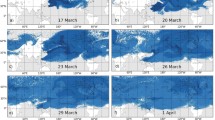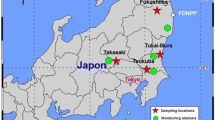Abstract
The radon and radon daughter concentration-in-air from natural background are assessed along with the micrometeorology and synoptic weather systems in an arid region of Australia. The radon daughter contribution to population dose is biased towards the frequency of nocturnal inversions. Classical atmospheric models are not applicable during stable atmospheric conditions in inland Australia. An atmospheric Box Model is used along with measured data from tethersonde profiles in predicting radon/radon daughter concentration-in-air. Predicted and measured concentrations are compared for spatial and temporal variations.
Similar content being viewed by others
References
Alter, H. W. and Fleishcher, R. L.: 1981, ‘Passive Integrating Radon Monitor for Environmental Monitoring’, Health Phys. 40, (5), 693–702.
Bevington, P. R.: 1969, ‘Data Reduction and Error Analysis for the Physical Sciences’, 1st Edition, McGraw-Hill Publication, New York.
Businger, J. A., Wyngaard, J. C., Izumi, Y., and Bradley, E. F.: 1971, ‘Flux-Profile Relationships in the Atmospheric Surface Layer’, J. Atmos. Sci. 28, 181–189.
Hanna, S. R., Briggs, G. A., and Hosker, Jr. R. P.: 1982. ‘Handbook of Atmospheric Diffusion’, U.S. DOE Report TIC-11223, 1–102.
ICRP Publication 32.: 1981, ‘Limits for Inhalation of Radon Daughters by Workers’, Annals of the International Commission on Radiological Protection, 6 (1), Pergamon Press, Oxford.
Leach, V. A., Lokan, K. H., and Martin, L. J.: 1982, ‘A Study of Radiation Parameters in an Open-Pit Mine’, Health Phys. 43, 363–375.
Leach, V. A.: 1988, ‘Atmospheric Influences on Radon/Radon Daughter Dispersion from the Ground’, Master of Science Thesis-Melbourne University.
Lyons, T. J. and Steedman, K.: 1981, ‘Stagnation and Nocturnal Temperature Jumps in a Desert Region of Low Relief’, Boundary Layer Meteorol., 21, 369–387.
McVehil, G. E.: 1964, ‘Wind and Temperature Profiles Near the Ground in Stable Stratification’, Quart. J. Roy. Meteorol. Soc., 90, 136–146.
Solomon, S. B., Peggie, J. R., Grearly, G., and Leach, V. A.: 1987, ‘An Integrating Thermoluminescent Rn Daughter Personal Dosemeter’, Health Phys. 52 (5), 143–148.
Author information
Authors and Affiliations
Rights and permissions
About this article
Cite this article
Leach, V.A., Chandler, W.P. Atmospheric dispersion of radon gas and its decay products under stable conditions in arid regions of Australia. Environ Monit Assess 20, 1–17 (1992). https://doi.org/10.1007/BF00396516
Issue Date:
DOI: https://doi.org/10.1007/BF00396516




